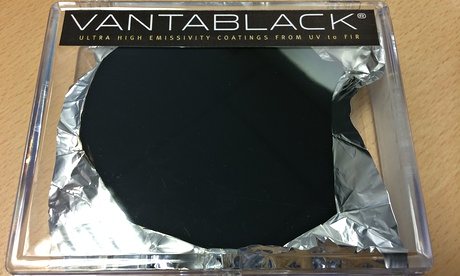Friday 11th March 2016Anish Kapoor and the Lure of Vantablack

Anish Kapoor, the well-known British artist who has designed a number of public artworks and architectural projects including the popular Cloud Gate sculpture in Chicago, has a brand new feather in his cap - although it's almost impossible to actually see.
Thanks to recent advances in nanotechnology, a firm based in the United Kingdom named Surrey NanoSystems has developed a material so dark that it absorbs 99.96% of all the light that hits it, known as Vantablack. As most artists know, objects take on colour by reflecting all the other wavelengths of light. A mirror reflects almost all the light that hits it, making it a near-perfect representation of the
“It's blacker than anything you can imagine. It's so black you almost can't see it. It has a kind of unreal quality. I've been working in this area for the last 30 years or so with all kinds of materials but conventional materials, and here's one that does something completely different," he explained. “I've always been drawn to rather exotic materials."
The deal naturally has some artists rather frustrated by the exclusive licensing deal between Surrey Nanosystems and Kapoor, suggesting that the quest for the darkest blacks has always been the province of dedicated artists throughout the course of history.
It's not the first time that artists have been granted exclusive access to use a particular colour, although there seems to be little available data how regularly someone would challenge such a patent agreement. Perhaps this is simply due to shoddy recordkeeping, or perhaps its due to the fact that it's hard to maintain your artistic credibility by using something so intimately associated with a single person. As far back as 1960, French artist Yves Klein created and patented a shade of blue known as International Klein Blue which he used to create a series of paintings, but to most people today it would be recognized as the same blue that adorns the faces of the art-theatre troupe The Blue Man Group.
Kapoor won't be the only person who has access to the nanomaterial, as several manufacturers have expressed intense interest in using the material, but the deal he has signed gives him exclusive license to develop the material into a spray-type "paint" and then use it in his projects, which means he is effectively the only artist in the world who will have access to it.
For now. With the technology needed to conduct nanotechnological research, it's probably only a matter of time before a competing firm comes up with a similar material, although it's still quite a coup for Kapoor.
Posted on March 11th 2016 on 04:47am
0 Comments
 Anish Kapoor, the well-known British artist who has designed a number of public artworks and architectural projects including the popular Cloud Gate sculpture in Chicago, has a brand new feather in his cap - although it's almost impossible to actually see.
Anish Kapoor, the well-known British artist who has designed a number of public artworks and architectural projects including the popular Cloud Gate sculpture in Chicago, has a brand new feather in his cap - although it's almost impossible to actually see.



